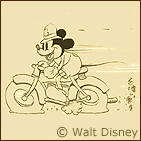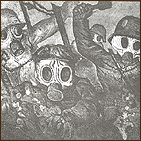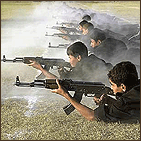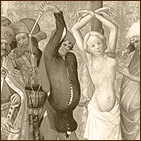 |
 |
 |












Walt Disney 1901 - 1966


















Fernando Botero




Tom Wolfe












Prof. Dr. Helge Bathelt
 |
|
|
 |

 |
 |

The following text
is not only meant for a tough group of interested people.
That's why I've placed some pics to the lines,
to liven things up a bit. |
|
|
 |
About the Art
 |
The works
It is not the person but the work of the artist that should be placed in the foreground. This is especially so when the works of the artist reveal as much biographical detail as in those of Hardy Ecke. His works are the key to understanding his personality. |
Comics and graphics
What first attracts the eye is that Ecke presents the people in his paintings with clear contours and that they are distinguished from each other by powerful contrasts of colour. In this way, clean pictorial spaces are created which are reminiscent of the world of comics and commercial graphics, from which Ecke, after all, has only recently taken his leave. |
Child's view
The loose apparel containing the full and rounded shapes looks somewhat like confirmation clothes worn for the first time. Ecke's figures present a picture of humanity which impresses the observer as being a child's view.
The people portrayed display a soft anxiousness, thus making them appear harmless and friendly in a sympathetic way.
That he uses pictorial means to stimulate understanding and produce a feeling of willingness to help on both sides demonstrates a very human characteristic of his art. One feels one would like to help the characters in his pictures in some way. They need our help just as we need theirs. |
Proportions
Hardy Ecke achieves this effect by making use of specific effects with regard to layout. He surrounds his characters with bare pictorial spaces which isolate the figure. Shadows are used sparingly with an additional effect of emphasising the figures and making them stand out. When drawing them, Ecke is celebrating with obvious pleasure the opulence of the well-nourished infant. Feet and hands are magnified, thus strengthening the motif of youth; a trick which Michelangelo resorted to in his opulent "David". |
Germany 1989
Everyone was deeply moved by the events of autumn 1989 when the internal German frontier was opened and the Berlin wall came down. Hardy Ecke was born in Berlin. "I would never have forgiven myself if I hadn´t been there," he wrote in commentary on his picture "11th November - Potsdamer Platz" which is a permanent document of the atmosphere of those days. |
Three Men
Among the paintings by Hardy Ecke, there is certainly none which reveals so much of the answer to the question of his spiritual origins and those who influenced him than the painting with the title "Three men at the black table". In an atmosphere of concealed, impending rebellion, in the red colour of revolution, of power and renewal and of a deep-seated brotherhood, Hardy Ecke sits at the table with Walt Disney and Fernando Botero.
Encouragingly, Disney pats the Colombian artist born in 1932 on the shoulder who thoughtfully - perhaps smilingly as well - observes one of Ecke´s postcards. Is Hardy Ecke´s painting "Three men at the black table" a symbiosis of the two men who had a great influence on him?
In honouring and paying homage to Disney and Botero, however, Ecke develops completely independent and unmistakable stylistic and expressive characteristics. There is, for example, the increasingly massive heads of the figures in Ecke´s paintings, their accompanying disproportion - often felt as ampleness - and the intended reduction to the essential. All this is a reminder of Botero´s figures. In complete contrast to Botero, on the other hand, Ecke gives his characters large expressive eyes as if they were comic figures from Disneyland. |
The eyes
Ecke designates the eyes as the first and most outstanding means of communication. In this way, he awards them special significance in his pictures of human beings.
Ecke´s striving for a homogeneous surface of the image, the avoidance of depth perspective and background painting, his contours and often hard contrasts of that which is portrayed is combined with graphic elements of style. |
The freedom I mean
In 1990, Ecke made the decision to devote his life from then on exclusively to painting. This resolution is manifested in the picture "The freedom that I mean". After 10 years of successful work in the world of commercial graphics, a risk, a courageous leap into the unknown. With gestures of a jubilant leap into the air and a dancing relief, Hardy Ecke celebrates his decision to exist independently as an artist. |
Gulf war
In addition to the colourful pictures which suggest happiness, those stand out which, with their monotonous colouring, look sadder and are of a higher moral sentiment. In these pictures as well, the people portrayed appear harmless even when closer observation of the images indicate highly problematic interconnections such as is the case in the Near-East triptych
"Sic transit gloria mundi" - thus passes the glory of the world.
With an analytic mercilessness reminiscent of Otto Dix, Ecke points out social injustices. As Ecke says, "In a time when our children undergo a gentle upbringing and, in prams which are almost hermetically sealed, are pushed through the rain, a time in which mothers are often seen carrying their children like porcelain puppets, we are confronted with images of women who are prepared to sacrifice their whole families for a so-called "holy war".
"Are we abusing our children?
Do we possess this world?
Have we really evolved since the middle ages?"
A torturer such as the Syrian Hafis Assad is presented with a cheque for DM 100 million by our foreign minister. A dictator who tomorrow can go to war against us using our own weapons in the next Gulf war. The dead of the Gulf war in 1991 are not even cold and the seeds of a new war are being sown. In conclusion, Hardy Ecke warn:
"Sow the wind and harvest the storm." |
Chaos - much-too-much
In a time of pluralism and the often accompanying insecurity and excessive demands made on people - especially in the field of art - Hardy Ecke´s paintings have an unmistakable effect in both their formal and artistic statements. "My painting is orderly," says Ecke.
In the chaos of demands, in the much-too-much that has to be coped with every day, his works are comparable to oases. |
Humans
Ecke, who loves working to the sound of a waltz and has also absorbed the rock music of the 70s, is in the depth of his heart a deeply happy and humorous, life-loving and positive person.
His muse in underwear with the Madonna-like C- or is it a D-cup, the shocked and easily sweating educated citizen in the opera square of intolerance, the friendly vodka-drinking good neighbour from a Moscow suburb, the computer-controlled confused pirate and especially the free-wheeling Hardy Ecke himself, having escaped from industrial recycling: an accumulation of recognisable types, taken from the everyday life in which they exist and in which they have settled down - as best as possible. |
Madness, murder and mayhem
The rounded fingers of his figures, however, also touch wounds. The Australian aborigines, for example, wait with their question as to why they should pay for their own land, chumminess is recorded with murderers, fanaticism and financial machinations and made unavoidable as a "Triptych of Accusation", the "man in the street" is confronted with the symbols of power and, sitting at the same table as the devil, has to concede that the evils of this world cannot be done away with; two extraterrestrials play the "Humanity Game" on computer and do not manage to steer "their" human people living in a peacefull harmonie. These exterminate themselves mutually. - Game over.
With many of the pictures quoted as examples, Ecke has of course remained true to his original trade; advertising. Simple forms, clear colours, straightforward formats are the media for his messages. |
Don Quixote
He describes himself as a storyteller who is basically striving for a world which should be aware of its actions instead of denying by intentional repression the truth.
Essentially, Ecke believes in being able to have an educational effect when he translates known themes into pictures bearing witness to them, when he aims for understanding with economical means.
Does he achieve more with his efforts than by acting like a Don Quixote who fences in his Rosinante in each picture in order to lose against the windmill of facts, the force of reality and the unavoidable course of events? |
The hopeless struggle
The answer to this question has long been decided by the art critics. Art as a medium of warning has been declared dead.
No reason, however, for someone like Botero and someone like Ecke - this relationship of the spirit and form must be mentioned here so that Ecke does not appear to be a Parsifal - no reason then to at least clean out the framework of an art with an obligation to society, to adorn it with pink flesh, stubby fingers, wondering eyes and to make it tilt against the windmills of repressed truth again and again.
Whoever fights battles that can only be won may succeed as a manager or a general. Our time demands more of the person and the artist as well.
The hopeless struggle is the one which no-one takes part in any more. |
 |
Art critique
If we open another chapter in the picturesque narrative style of the artist, we come to a highly aggressive area in which he dares a humorous skirmish with his abstract colleagues.
There is for example a painting which brings the art critic Tom Wolfe into the picture who, in his book "The painted word", makes the proven claim that the recognition of art as art is performed by critics. The lords of art of his time are found in the Ecke picture as three strange mountain images in the background, which makes sense, their names being Greenberg, Rosenberg and Steinberg. ("Berg" is the German word for mountain.)
Ecke´s meeting with his "three-lines-in-three-seconds-finished fellow painters" becomes specially clear in the picture "The Emperor´s New Clothes" where a naked monarch in a stately pose is nailed into an abstract picture-in-a-picture scenery and a non-comprehending Van Gogh turns away form the scene. |
Literature
Ecke´s treatment of contemporary literature is also a "broad topic" ("Ein weites Feld/broad topic", the title of Günter Grass` latest novel), even when it concerns Günter Grass´ "The Butt", the chapter of the third month and the story of Margarte Rusch. "Fat Gret" rides into town naked on the sow in that merry baroque attitude to life. She speaks to her father, the smith Rusch, above whom the sword has been hung, after the hangman´s supper, saying that he can count on her revenge. |
 |
Witches
The fact that Ecke´s ambition to make social criticism must not be overlooked is shown by his work. The topic of witch hunting: naked female bodies between ideologues of pain and thugs who remain in grey-satanic shades and thus are eloquently contrasted with those being tortured. |
 |
The apeman-series
"Still life with Negro puppets" is also diagnostic of society as is the "Apeman series" especially. The topic is just as topical as it is incredible. France continues to detonate atom bombs below the Mururoa Atoll. Is this an end with terror or terror without an end, Ecke asks himself, inspired by the prophetic texts from the music scene of previous decades (The Kinks "Apeman") which warn what mankind is prepared to do to nature and to itself.
Once again, nothing learned and Ecke puts his finger on this in his paintings. He does not have to do this with surreal means as reality itself has taken on surrealistic features. He, the artist, as a political animal has to act with the means of his art and make his contribution towards the glaring obviousness of this piece of "contemporary history." |
Still life
"Still life with hornets" and "Taboret with Tangerines" are colourful orientations towards the real and act like retarding moments in the limitless urge of the artist to create fables - they do not advance knowledge or educate but denote the artist as a painter of forms and colours.
With his mimetic pictures, Ecke provokes the observer into fantasising as well, just like the artist himself. Stylistic and technical questions are solved as a matter of course by putting them last. |
Addendum
A bit of Parsifal and a bit of Don Quixote, he holds firmly to his art which acts as a medium of clarification and shows the ambition of leading people out of their self-incurred stupidity. Whether he succeeds is a question Ecke has to submit to and the answer can only come from the public. The ambiguousness, however, of a caricature-like line on the one hand and critical content on the other has always been a favourite area.
Ecke has an elegant and penetrating way of going about it and no-one can say that he left an exhibition of Ecke´s work just as he had come to it. The observer is not left unaffected, an effect ensured by the artist´s work to the best of his knowledge and ability. |
The authors
Prof. Dr. Helge Bathelt, Michaela Fischer, Hardy Ecke


Helge Bathelt retired in 2013. The hunter and gatherer of art is stepping back.
The director of the community college and head of the City Gallery, loves to pose in front of the portrait by Hardy Ecke.
|
 |
|
|
|

